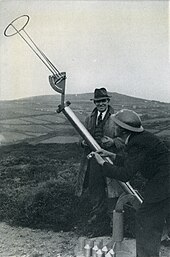Steam cannon
The steam cannon was an artillery piece of antiquity and goes back to Archimedes . It essentially consisted of a straight tube made of copper that was sealed at one end. First a small amount of water was put into the cannon and then a precisely fitting 8 kg ball. By starting a fire at the closed end, the water should suddenly be converted into water vapor ; the resulting pressure should drive the bullet out of the barrel. According to the calculations of Leonardo da Vinci , the range of this cannon should be about 1250 m.
To what extent this gun was put into practice by Archimedes is no longer understandable today. However, modern replicas have proven the functionality of the steam cannon. At least in theory , Archimedes made technical use of water vapor .
In later times, the concept of a steam gun was occasionally taken up, among other things around 1826-28 in the Russian Empire and in Great Britain during World War II ( Holman Projector ) to experimental prototypes, but their military use was very little.
See also
literature
- Sigvard Strandh: The Machine; History, elements, function. ISBN 3-451-18873-2 , p. 28.

